Transfinite Elements Using Bernstein Polynomials
Abstract
1. Introduction
- Tensor product elements.
- Classical transfinite elements (fully structured).
- Distorted tensor products.
- Elements with different degrees on opposite edges (partially unstructured).
- Coons elements.
2. Basic Theory
2.1. Bernstein Polynomials
2.2. Relationship Between Bernstein and Lagrange Polynomials
2.2.1. Univariate Approximation
2.2.2. Tensor Products
2.3. Non-Uniform Lagrange Polynomials
3. Transformation Matrices Between Tensor Product Bernstein and Lagrange Functional Sets
3.1. Quadratic Interpolation
3.2. Generalization
3.3. Transformation of Structural Engineering Matrices (K,M)
| Significant Remark: Comparing the equilibrium equations in terms of Lagrange polynomials according to Equation (22) with those in terms of Bernstein polynomials according to Equation (27), one may understand that the numerical solution of each of them equals the numerical solution of the other. Similar findings regarding the equivalence of the two polynomial bases may be derived for the eigenvalue problem and transient analysis as well. |
3.4. Numerical Verification
3.5. Cross-Check
4. Classical Transfinite Elements
- Blending functions. For each direction ( or ), the number of blending functions equals the number of corresponding stations, and thus their polynomial degree ( or , accordingly) equals . For example, in the 21-node element shown in Figure 3, there are three stations per direction and thus . Perpendicularly to the -direction (toward -axis), the first vertical station is the edge (with nodes 1-6-9-14-17), the second vertical station consists of the nodes (3-7-11-15-19), and the third one includes the nodes along edge (with nodes 5-8-13-16-21). Similarly, perpendicularly to the -direction (toward -axis), there are also three horizontal stations, i.e., the edge (with nodes 1-to-5), the isoline made of nodes (9-10-11-12-13), and eventually the edge (with nodes 17-to-21).
- Trial functions. These refer to the interpolation along the stations. In this example, each station consists of 5 nodes (4 node spans), and thus the polynomial degree will be (e.g., along the horizontal edge ), and similarly (e.g., along the vertical edge ). In general (for other discretizations), we have .
4.1. General Relationships Between Initial and Transformed Bases
4.2. Structured Transfinite Elements
4.3. Numerical Verification of 21-Node Traditional Transfinite Element
5. Distorted Tensor Products and Partially Unstructured Transfinite Elements
5.1. Simple Distortion
5.1.1. Closed-Form Expressions
5.1.2. Numerical Verification
5.2. Distortion Combined with Node Refinement or Removal on Edges
- Shape functions associated with corner nodes consist of three terms (influenced by all the three projectors, and ).
- Shape functions associated with intermediate nodes on the edges consist of one term, which is related to the projector having as a subscript the axis perpendicular to the current edge. For example, the shape functions of nodes along edge are influenced by only the projector .
- Shape functions associated with internal nodes equal to the tensor product of the blending functions only.
5.2.1. Justification
- The function consists of six nodal values , which define 5 node spans and fully define a polynomial of degree 5. Note that the artificial nodes are not included because they are not needed.
- The function consists of 5 nodal values (4 node spans), and thus fully defines a polynomial of degree 4. Note that the artificial node K, on the boundary, is required to determine the missing end of nodal sequence.
- The function consists of 5 nodal values (4 node spans), and thus fully defines a polynomial of degree 4. All entries of the nodal sequence are primary nodes that belong to the 27-node element.
- The function consists of 5 nodal values (4 node spans), and thus fully defines a polynomial of degree 4. Note that the artificial node L is required to determine the missing end of the nodal sequence.
- The function consists of four nodal values , defining 3 node spans and fully defining a polynomial of degree 3. Note that the artificial nodes , on the boundary, are not included because they are not needed.
- The projector includes two out of the eight artificial nodal values.
- The projector includes the rest six out of the eight artificial nodal values.
- The subtractive corrective projector includes all the eight artificial nodes.
- We notice the terms , coming from and .
- We notice the terms , coming from and .
- We notice the terms , coming from and .
- We notice the terms , coming from and .
- We notice the terms , coming from and .
- We notice the terms , coming from and .
- We notice the terms , coming from and .
- We notice the terms , coming from and .
- The transformation matrix , which fulfils the relationship , is determined by applying it to all the 27 nodal points of the element; we receive that det .
- The recalculation of the Lagrange-based bivariate shape functions in terms of the Bernstein-based ones , using the relation , shows a large error (about ) in the interior of the element, whereas on the boundary and at the nodal points it vanishes.
- A similar discrepancy was observed when the relationship was applied to more points, and this least-squares scheme led again to a similar deviation between the initial and the recalculated values.
5.2.2. Numerical Verification
- The requirement to use the parameters defined by the nodal points of the Lagrange model, and then map the control points to the nodal points , leads to coincidence between them.
- In both systems, the determinant of the Jacobian all over the rectangular domain is equal to unity.
- The error norm was found to be slightly different in each system: for the Lagrange polynomials and for the Bernstein ones.
6. Coons Interpolation
6.1. Numerical Verification
7. Numerical Solution of Eigenvalue Problem
8. Discussion
- For four broad classes—namely, (i) Coons elements, (ii) tensor product elements, (iii) classical transfinite elements with a structured pattern of internal nodes, and (iv) distorted tensor product elements—Bernstein polynomials can directly replace Lagrange polynomials of the same degree, yielding identical accuracy.
- In a fifth class, involving transfinite elements with arbitrary boundary nodes and a tensor product distribution of internal nodes, Bernstein polynomials may also be used in place of Lagrange polynomials of the same degree. However, this substitution does not guarantee identical results. While the overall performance of such arbitrarily noded transfinite elements remains satisfactory for practical applications, further investigation is needed, especially in cases involving non-uniform polynomial degrees.
9. Conclusions
Funding
Institutional Review Board Statement
Informed Consent Statement
Data Availability Statement
Conflicts of Interest
Appendix A. MATLAB Script for Matrix Comparison
| Listing A1. Auxiliary MATLAB code to experiment with the matrix as a matrix of size 3 × 3 or as a column-vector of size 9 × 1, for quadratic interpolation (p = 2). |
| clear all |
| clc |
| syms U1 U2 U3 U4 U5 U6 U7 U8 U9 |
| syms A1 A2 A3 A4 A5 A6 A7 A8 A9 |
| syms R |
| Tx = [ 1 −1/2 0 |
| 0 2 0 |
| 0 −1/2 1]; |
| Ty = Tx; |
| U = [U1 U4 U7 |
| U2 U5 U8 |
| U3 U6 U9]; |
| Aexact1 = Tx’ ∗ U ∗ Ty |
| Areconstructed = Aexact1 (:); |
| R = [… |
| 1 −1/2 0 −1/2 1/4 0 0 0 0 |
| 0 2 0 0 −1 0 0 0 0 |
| 0 −1/2 1 0 1/4 −1/2 0 0 0 |
| 0 0 0 2 −1 0 0 0 0 |
| 0 0 0 0 4 0 0 0 0 |
| 0 0 0 0 −1 2 0 0 0 |
| 0 0 0 −1/2 1/4 0 1 −1/2 0 |
| 0 0 0 0 −1 0 0 2 0 |
| 0 0 0 0 1/4 −1/2 0 −1/2 1 ]; |
| Uvector = transpose([U1 U2 U3 U4 U5 U6 U7 U8 U9]); |
| Aexact2 = R.’ ∗ Uvector |
| isEqual = isequal(Areconstructed, Aexact2); |
| if isEqual |
| disp(’The symbolic matrix and vector storage are equivalent.’); |
| else |
| disp(’The symbolic matrix and vector storage are NOT equivalent.’); |
| end |
References
- Zienkiewicz, O.C. The Finite Element Method, 3rd ed.; McGraw-Hill: London, UK, 1977. [Google Scholar]
- Bathe, K.J. Finite Element Procedures, 2nd ed.; Prentice-Hall: Hoboken, NJ, USA, 1996. [Google Scholar]
- Cottrell, J.A.; Hughes, T.J.R.; Bazilevs, Y. Isogeometric Analysis: Towards Integration of CAD and FEA, 1st ed.; Wiley: Chichester, NH, USA, 2009. [Google Scholar]
- Bernstein, S. Sur une modification de la formule d’interpolation de Lagrange (French, Russian abstract). Commun. Soc. Math. Kharkov 1932, 5, 49–56. [Google Scholar]
- Lorentz, G.G. Bernstein Polynomials, 2nd ed.; Chelsea Publishing Co.: New York, NY, USA, 1986. [Google Scholar]
- Amato, U.; Della Vecchia, B. Bridging Bernstein and Lagrange polynomials. Math. Commun. 2015, 20, 151–160. [Google Scholar]
- Cooper, S.; Waldron, S. The eigenstructure of the Bernstein operator. J. Approx. Theory 2000, 105, 133–165. [Google Scholar] [CrossRef]
- Occorsio, D.; Simoncelli, A.C. How to go from Bézier to Lagrange curves by means of generalized Bézier curves. Facta Univ. Ser. Math. Inform. (Nisˇ) 1996, 11, 101–111. [Google Scholar]
- Micchelli, C. The saturation class and iterates of Bernstein polynomials. J. Approx. Th. 1973, 8, 1–18. [Google Scholar] [CrossRef]
- Tachev, G. From Bernstein polynomials to Lagrange interpolation. In Proceedings of the 2nd International Conference on Modelling and Development of Intelligent Systems (MDIS 2011), Sibiu, Romania, 29 September–2 October 2011; pp. 192–197. [Google Scholar]
- Milovanović, G.V.; Udovičić, Z. Calculation of coefficients of a cardinal B-spline. Appl. Math. Lett. 2010, 23, 1346–1350. [Google Scholar] [CrossRef]
- Dyn, N.; Levin, D. Subdivision schemes in geometric modelling. Acta Numer. 2002, 11, 73–144. [Google Scholar] [CrossRef]
- Kočić, L.M.; Milovanović, G.V. Shape preserving approximations by polynomials and splines. Comput. Math. Appl. 1997, 33, 59–97. [Google Scholar] [CrossRef]
- Gautschi, W.; Milovanović, G.V. Spline approximations to spherically symmetric distributions. Numer. Math. 1986, 49, 111–121. [Google Scholar] [CrossRef]
- Frontini, M.; Gautschi, W.; Milovanović, G.V. Moment-Preserving Spline Approximation on Finite Intervals. Numer. Math. 1987, 50, 503–518. [Google Scholar] [CrossRef]
- Bustamante, J. Bernstein Operators and Their Properties; Springer: Cham, Switzerland, 2017. [Google Scholar]
- Provatidis, C.G. Non-rational and rational transfinite interpolation using Bernstein polynomials. Int. J. Comput. Geom. Appl. 2022, 32, 55–89. [Google Scholar] [CrossRef]
- Provatidis, C. Transfinite patches for isogeometric analysis. Mathematics 2025, 13, 35. [Google Scholar] [CrossRef]
- Provatidis, C.G. Precursors of Isogeometric Analysis: Finite Elements, Boundary Elements, and Collocation Methods; Springer: Cham, Switzerland, 2019. [Google Scholar]
- Gordon, W.J.; Hall, C.A. Transfinite element methods: Blending-function interpolation over arbitrary curved element domains. Numer. Math. 1973, 21, 109–129. [Google Scholar] [CrossRef]
- Coons, S.A. Surfaces for Computer-Aided Design of Space Forms; MIT: Cambridge, MA, USA, 1967. [Google Scholar]
- Farin, G. Curves and Surfaces for CAGD; Morgan Kaufmann-Elsevier: San Francisco, CA, USA, 2022. [Google Scholar] [CrossRef]
- Courant, R.; Hilbert, D. Methods of Mathematical Physics, 1st ed.; InterScience: New York, NY, USA, 1966; Volume I. [Google Scholar]
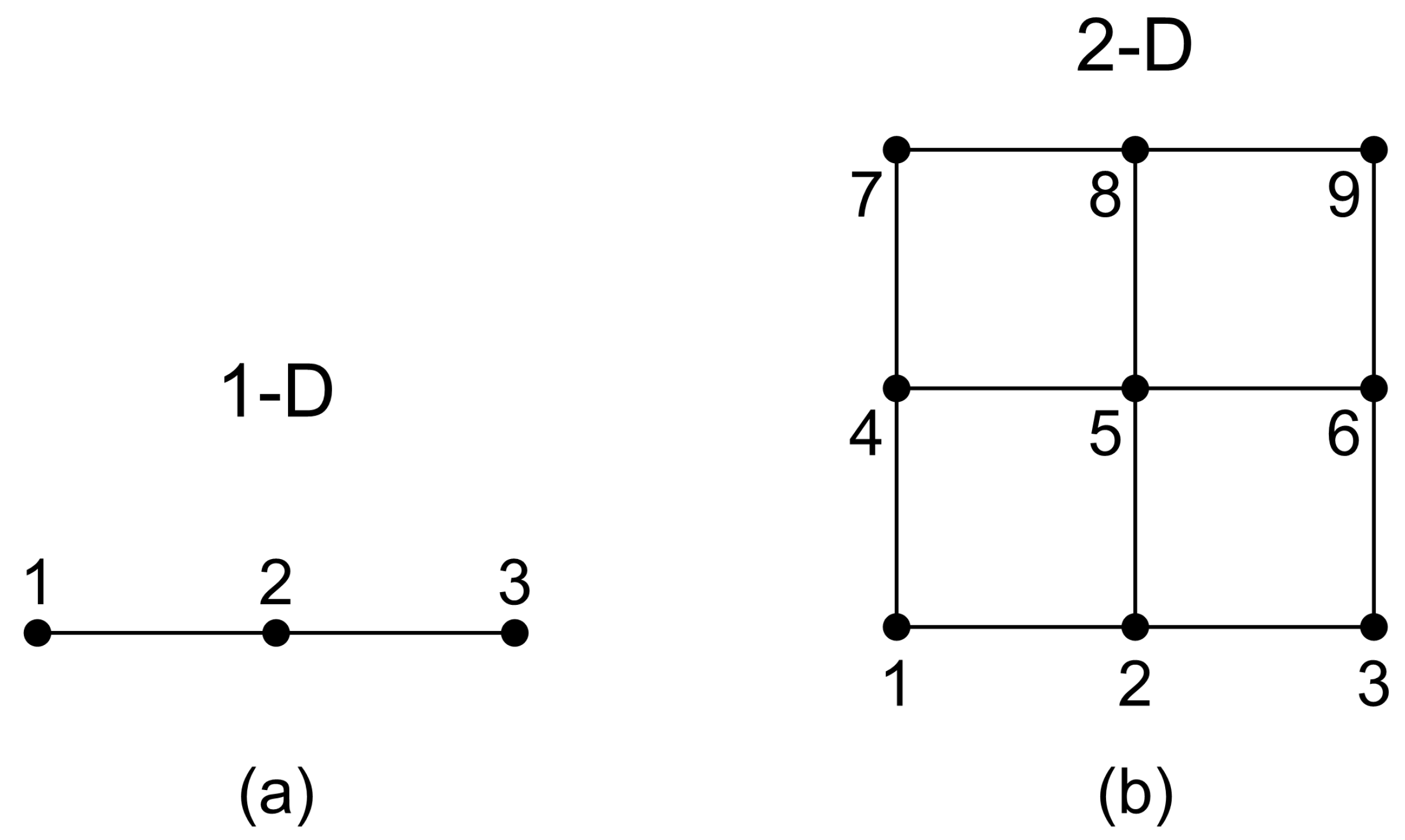
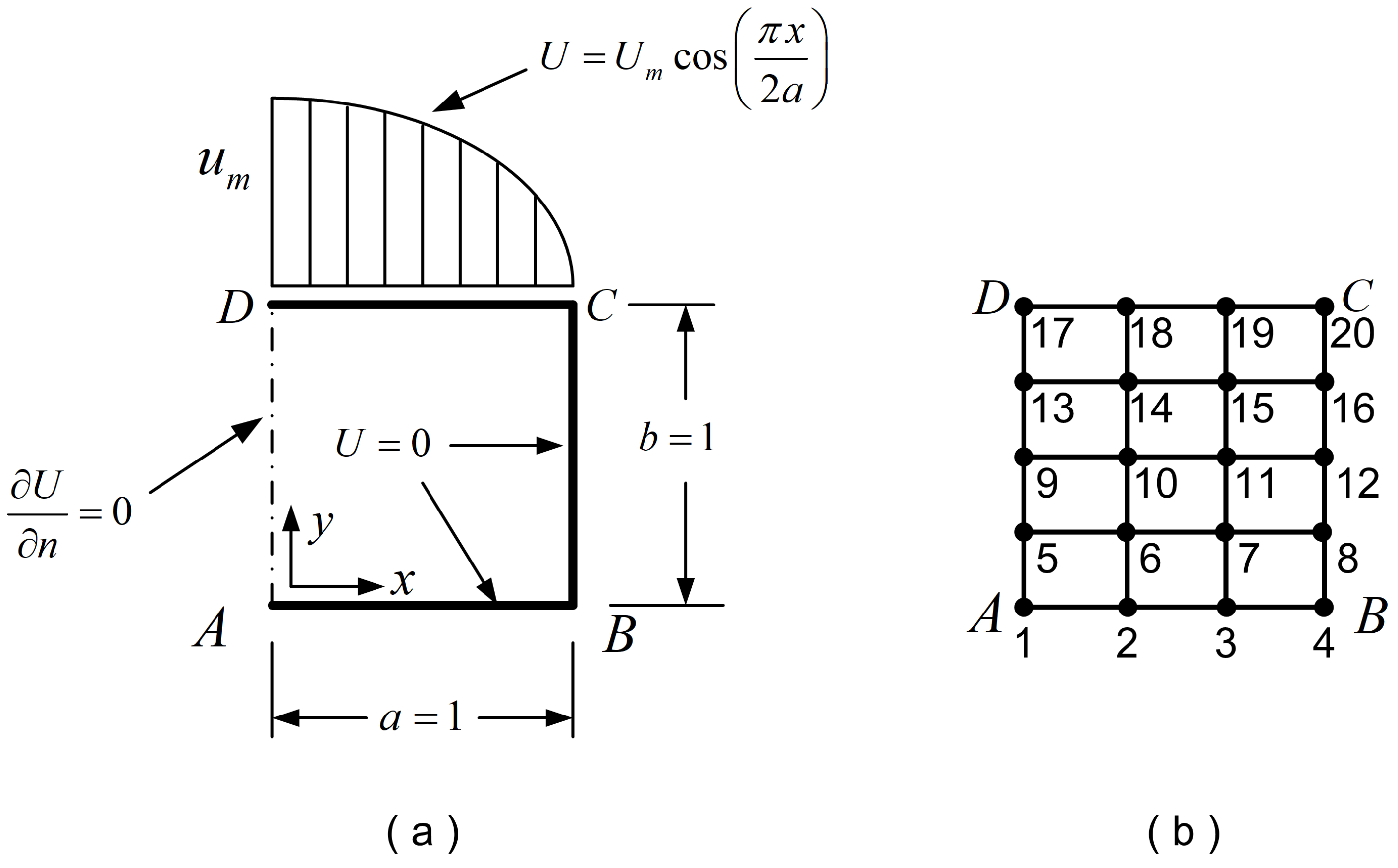

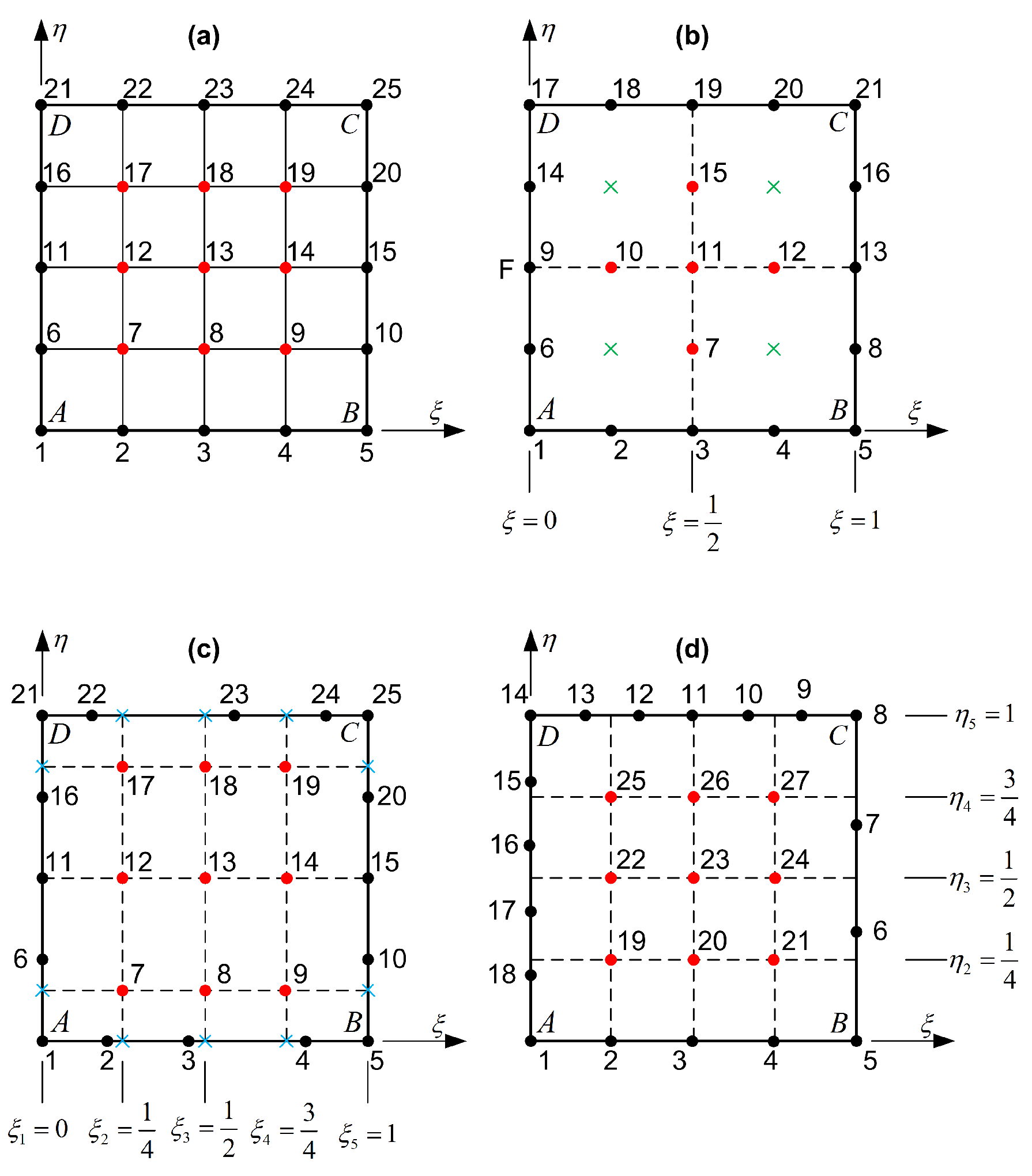

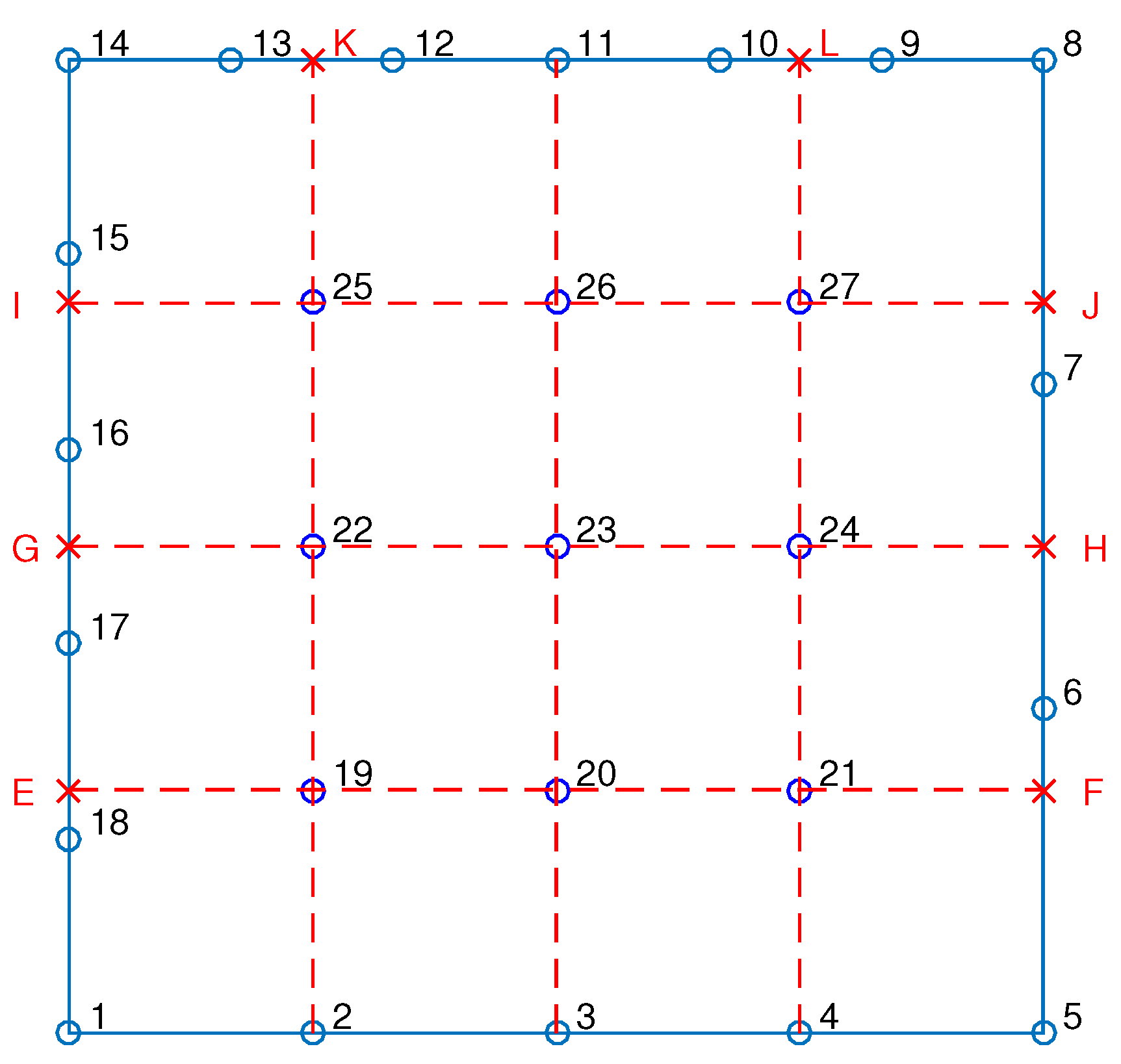

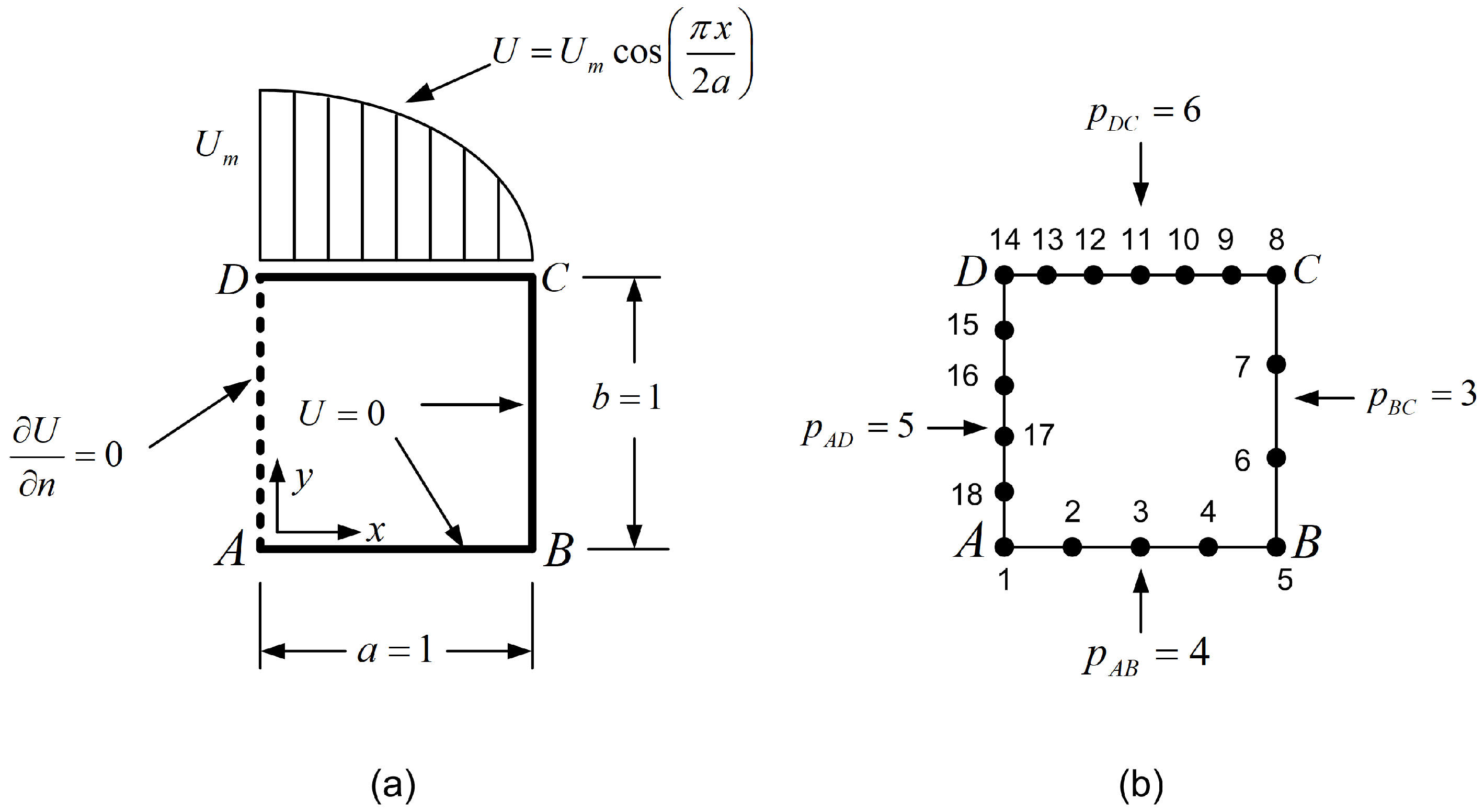
| Mode | Coons (18 DOFs) | Tensor Product Uniform (25 DOFs) | Tensor Product Distorted (25 DOFs) |
|---|---|---|---|
| 1 | – | – | – |
| 2 | 0.0175 | 0.0557 | 0.0557 |
| 3 | 0.2229 | 0.7256 | 0.7256 |
| 4 | 0.0141 | 0.0557 | 0.0557 |
| 5 | 0.3117 | 0.0557 | 0.0557 |
| 6 | 13.9526 | 2.1910 | 2.1910 |
| Mode | Lagrange-Based (27 DOFs) | Bernstein-Based (27 DOFs) |
|---|---|---|
| 1 | – | – |
| 2 | 0.0534 | 0.0420 |
| 3 | 0.6940 | 0.5404 |
| 4 | 0.0498 | 0.0361 |
| 5 | 0.0422 | 0.0309 |
| 6 | 2.1458 | 2.0581 |
Disclaimer/Publisher’s Note: The statements, opinions and data contained in all publications are solely those of the individual author(s) and contributor(s) and not of MDPI and/or the editor(s). MDPI and/or the editor(s) disclaim responsibility for any injury to people or property resulting from any ideas, methods, instructions or products referred to in the content. |
© 2025 by the author. Licensee MDPI, Basel, Switzerland. This article is an open access article distributed under the terms and conditions of the Creative Commons Attribution (CC BY) license (https://creativecommons.org/licenses/by/4.0/).
Share and Cite
Provatidis, C. Transfinite Elements Using Bernstein Polynomials. Axioms 2025, 14, 433. https://doi.org/10.3390/axioms14060433
Provatidis C. Transfinite Elements Using Bernstein Polynomials. Axioms. 2025; 14(6):433. https://doi.org/10.3390/axioms14060433
Chicago/Turabian StyleProvatidis, Christopher. 2025. "Transfinite Elements Using Bernstein Polynomials" Axioms 14, no. 6: 433. https://doi.org/10.3390/axioms14060433
APA StyleProvatidis, C. (2025). Transfinite Elements Using Bernstein Polynomials. Axioms, 14(6), 433. https://doi.org/10.3390/axioms14060433






